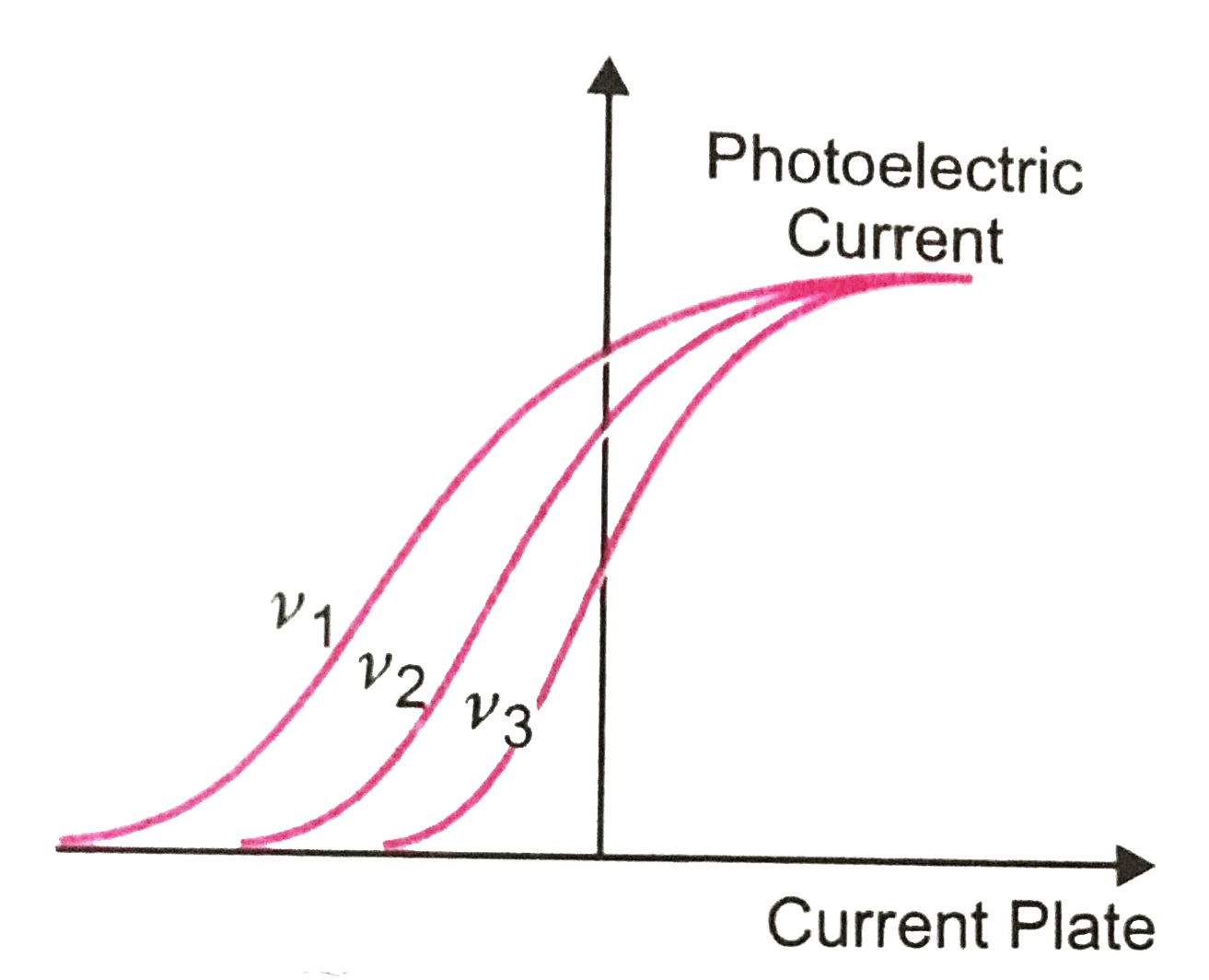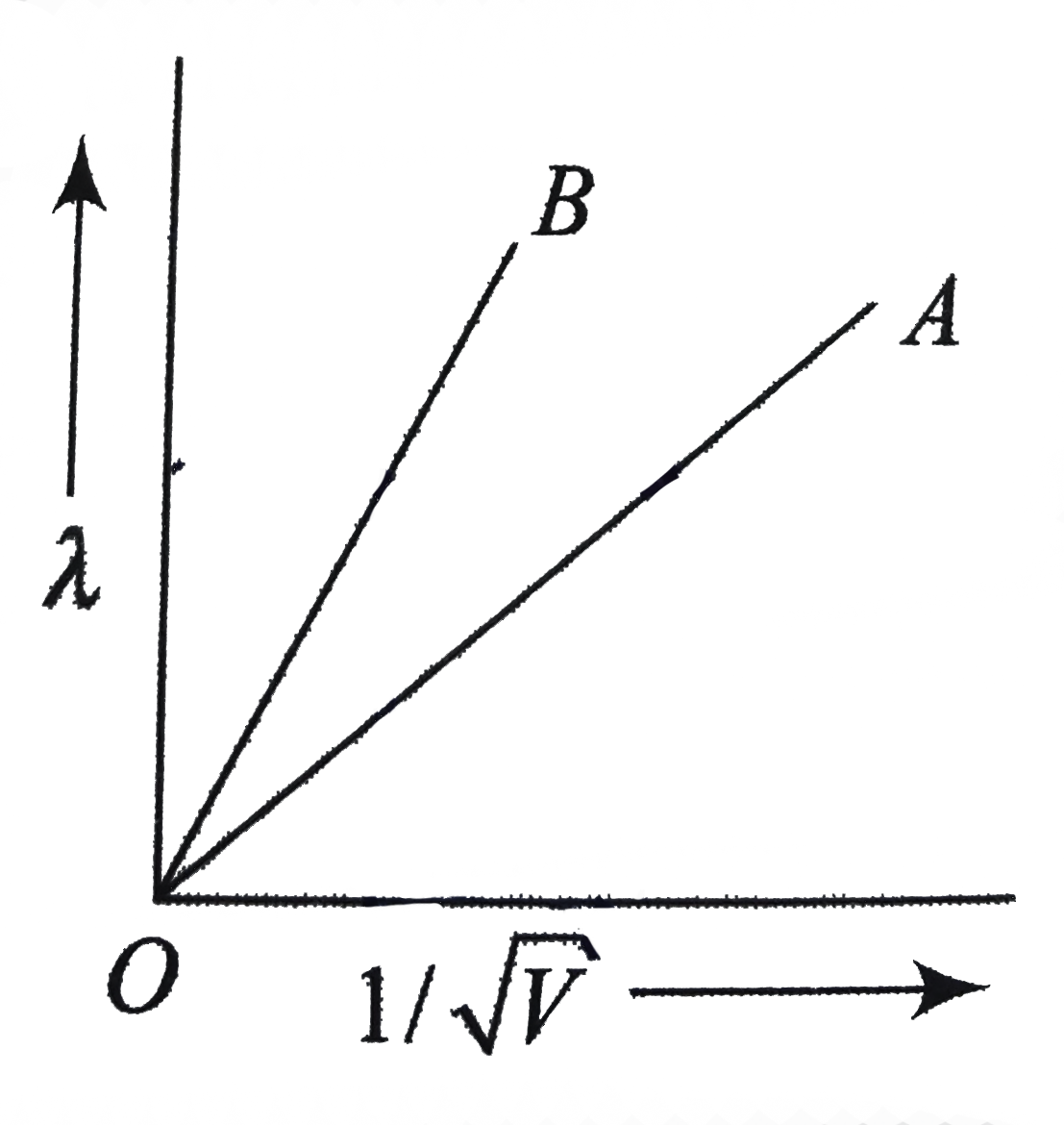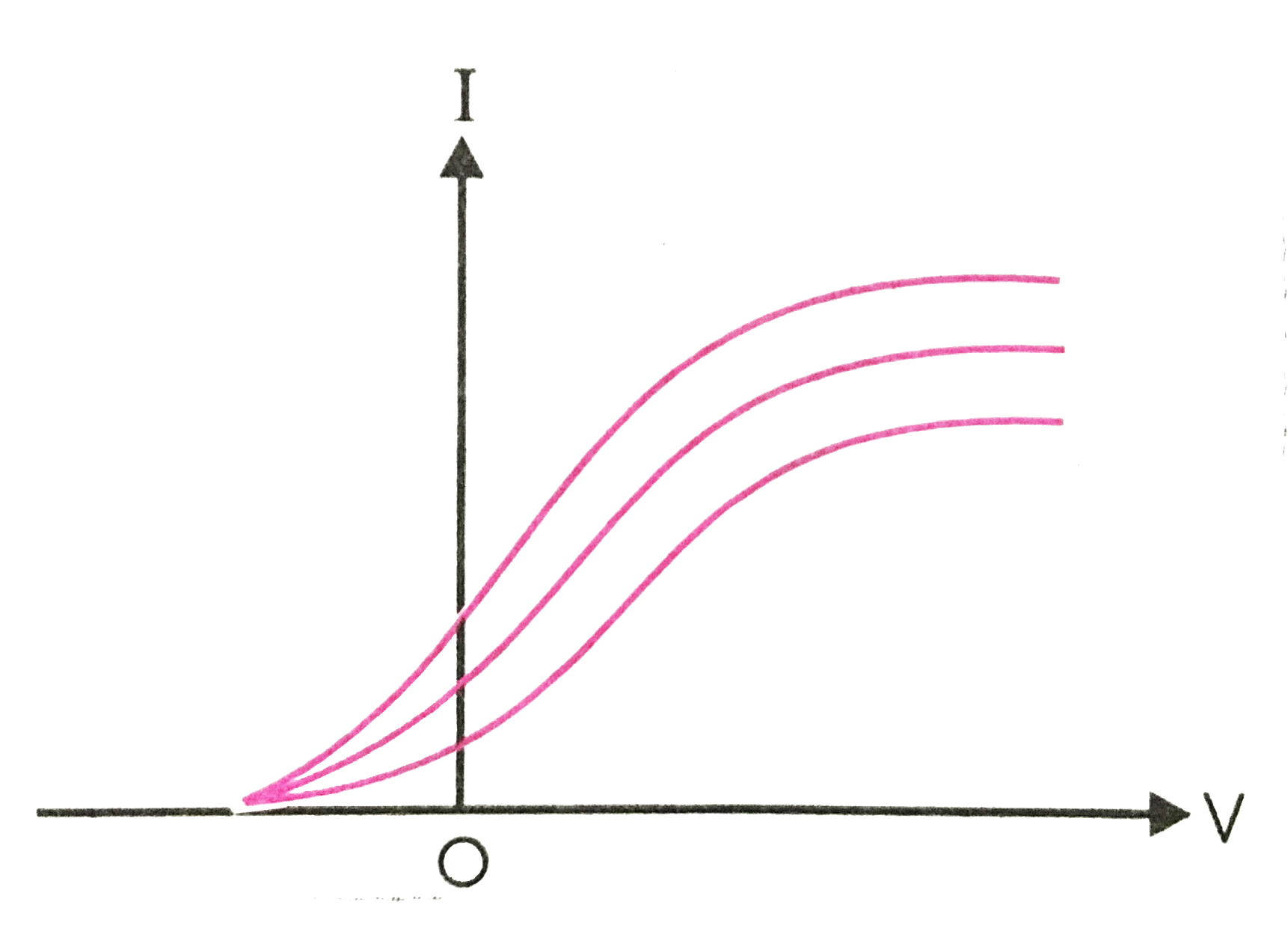Long answer from PRADEEP PHYSICS (HINGLISH) DUAL NATURE OF RADIATION AND MATTER for Class 12
| Class 12 | PHYSICS |
| Chapter | DUAL NATURE OF RADIATION AND MATTER |
| PRADEEP PHYSICS (HINGLISH) | Long answer |
| Medium | English |
| Academic Year | 2023-2024 |
Question 10
The work function for the following metals is given Na: 2.75 eV, K:2.30 eV , Mo: 4.17 eV , Ni: 515 eV.
Which of these metals will not give photoelectric emission for a radiation of wavelength 3300 A from a He−Cd laser placed 1m away from the photocell? What happens if the laser is brought nearer and placed 50 cm away?View SolutionQuestion 15
The work function for a metal is 1.8eV. Light of 5000Å is incident on it. Calculate (a) threshold frequency and threshold wavelength, (b) maximum kinetic energy of the emitted electrons, (c) maximum velocity of the emitted electrons, (d) if the intensity of the incident light be doubled, then what will be the maximum kinetic energy of the emitted electrons? given, h=6.63×10−34Js,me=9×10−31kg,c=3×108ms−1.View SolutionQuestion 16
Photoelectrons are emitted from a metal surface when ultraviolet light of wavelength 300nm is incident on it. The minimum negative potential required on it. The minimum negative potential required to stop the emission of electrons is 0.54V. Calculate:
(i) the energy of the incident photons
(ii) the maximum kinetic energy of the photoelectrons emitted
(iii) the work function of the metal Express all answer in eV. (useh=6.63×10−34Js)View SolutionQuestion 19
(a) The work function for the surface of aluminum is 4.2eV. How much potential difference will be required to stop the emission of maximum energy electrons emitted by light of 2000Å wavelength?
(b) What will be the wavelength of that incident light for which stopping potential will be zero ? h=6.6×10−34Js,c=3×108ms−1.View SolutionQuestion 20
(a) The work function for the surface of aluminium is 4.2eV. Find potential difference will be required to stop the emission of maximum kinetic energy photoelectrons emitted by light of 1800Å wavelenght?
(b) Determine the wavelength of that incident light for which stopping potential will be zero? (h=6.6×10−34)View SolutionQuestion 21
In an experiment on photoelectic effect, the graph between maximum kinetic energy (Kmax) and frequency of emitted photoelectron from metal surface is found to be a straight line as shown in fig. Calculate
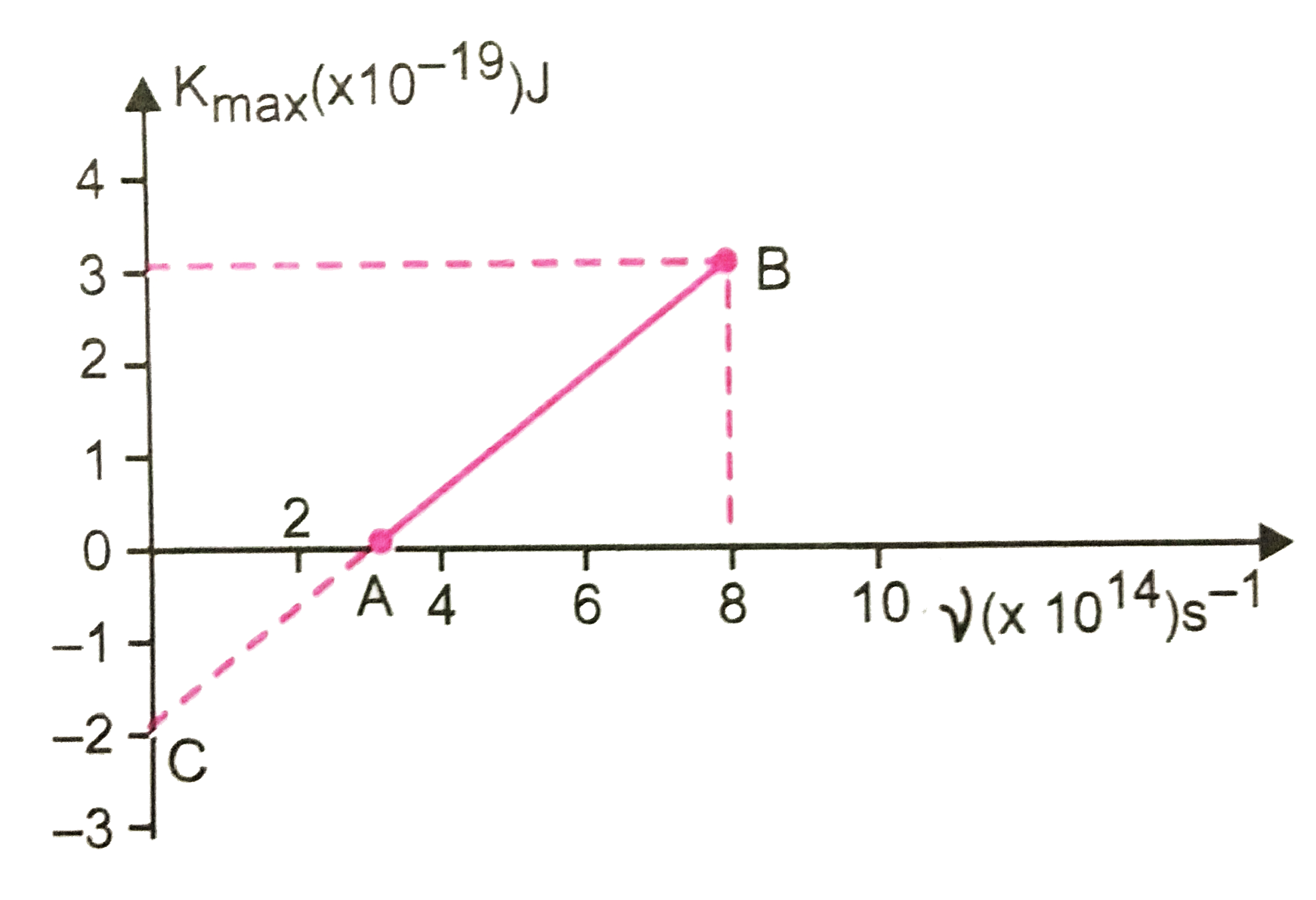
(a) thereshold frequency.
(b) work function of metal in electron volt.
(c) Planck's constant and
maximum kinetic energy of the emitted electron by light of frequency v=8×1014s−1.View SolutionQuestion 22
When a piece of metal is illuminated by monochromatic light of wavelength λ then the stopping potential for photoelectric current is 2.5 V0. When the same surface is illuminated by light of wavelength 1.5 λ, then the stopping potential becomes V0. Find the value of threshold wavelength for photoelctric emission.View SolutionQuestion 28
The wavelength of light in the visible region is about 390nm for violet colour, about 550nm (average wavelength) for yellow green colour and about 760nm for red colour. What are the energies of photon in eV at the (i) violet end (ii) average wavelength yellow-green colour and (iii) red end of the visible spectrum? (Take h=6.63×10−34Jsand1eV=1.6×10−19Js)View SolutionQuestion 41
a. A stopping potential of 0.82V is required to stop the emission of photoelectrons from the surface of a metal by light of eavelength 4000A. For light of wavelength 3000A, the stopping potential is 1.85V. Find the value of Planck's constant. [1 electrons volt (eV)=1.6×10−19J]
b. At stopping potential, if the wavelength of the incident light is kept fixed at 4000A, but the intensity of light increases two times, will photoelectric current be botained ? Give reasons for your answer.View SolutionQuestion 44
The extent of localization of a particle is determined roughly by its de Broglie wave. If an electron is localized within the nucleus (of size about 1014m) of an atom, what is its energy? Compare this energy with the typical binding energies (of the order of a few MeV) in a nucleus and hence argue why electrons cannot reside in a nucleus.View SolutionQuestion 45
Radiations of frequency 1015Hz is incident on three photosenstive surfaces. A,B and C. Following observations are recorded,
(a) Surface A. No photoemission occurs.
(b) Surface B. Photoemission occurs but the photoelectrons have zero kinetic energy.
(c) Surface C. Photoemission occurs and photoelectrons have some KE.
Based on Einstein's photoelectric equation, expalain the three observations.View SolutionQuestion 52
Fig. shows the variation of stopping potential V0 with the frequency v of the incident radiation for two photosensitive metal P and Q:
(i) Explain which metal has smaller threshold wavelength
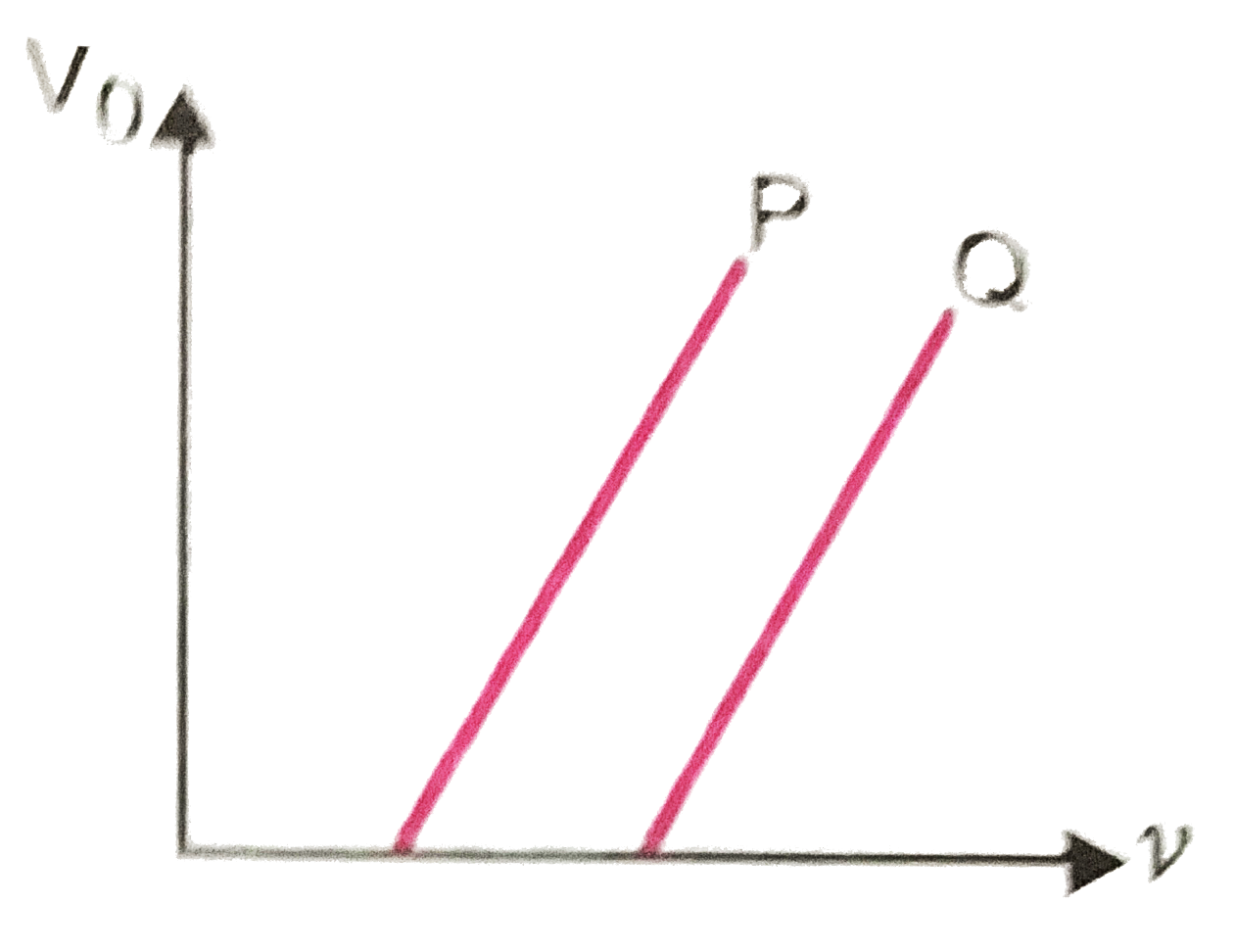
(ii) Explain, giving reason, which metal emits photoelectrons having smaller kinetic energy, for the same wavelength of incident radiation.
(iii) If the distance between the light source and metal P is doubled, how will the stopping potential change.View SolutionQuestion 53
In the study of a photoelectric effect the graph between the stopping potential V and frequency v of the incident radiation on two different metals P and Q is shown in fig.
(i) which one of two metals have higher threshold frequency
(ii) Determine the work function of the metal which has greater value
(iii) Find the maximum kinetic energy of electron emitted by light of frequency 8×1014Hz for this metal.
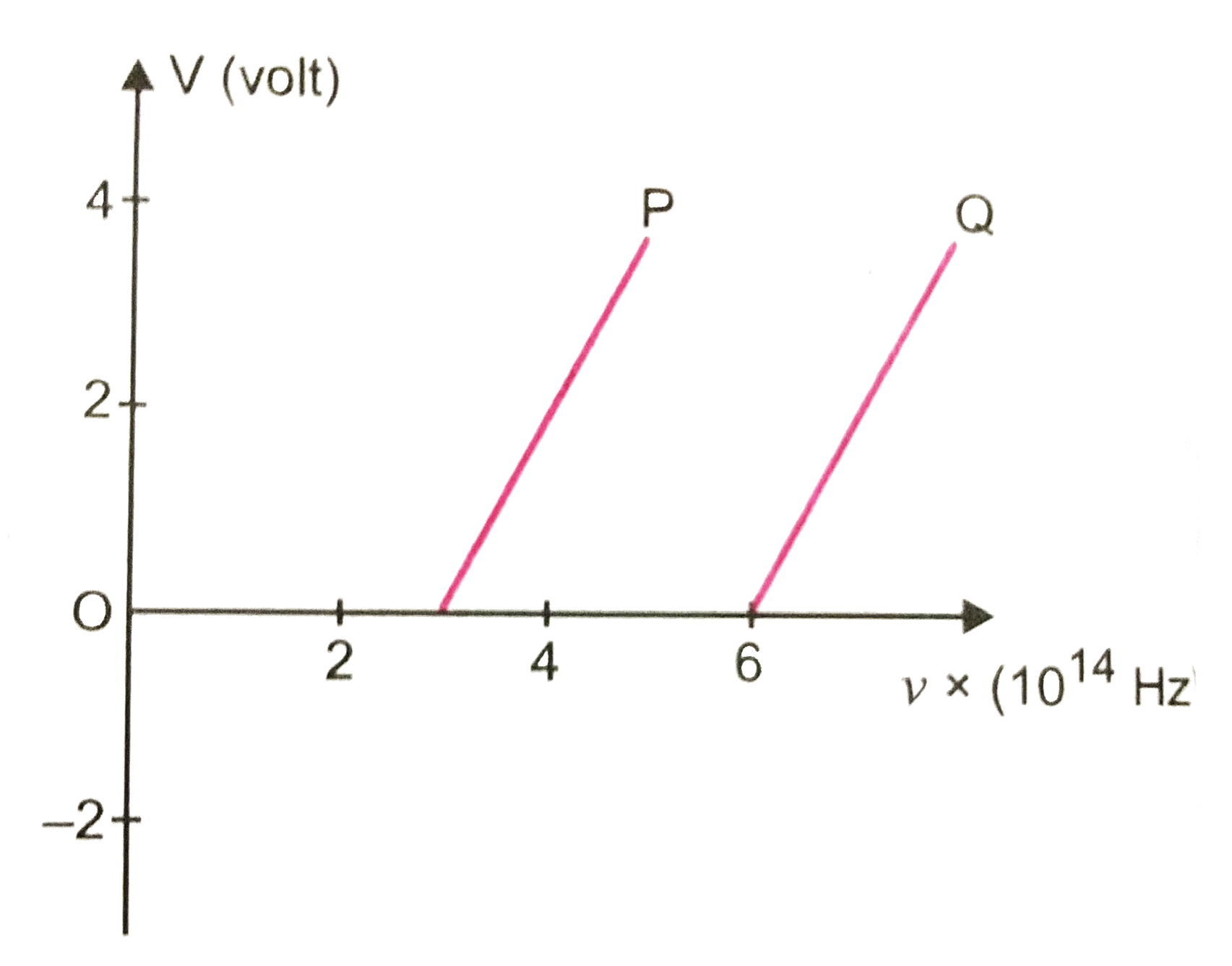 View Solution
View SolutionQuestion 54
fig. shows variation of stopping potential (V0) with frequency (v) for two photosenstive matrials M1andM2.
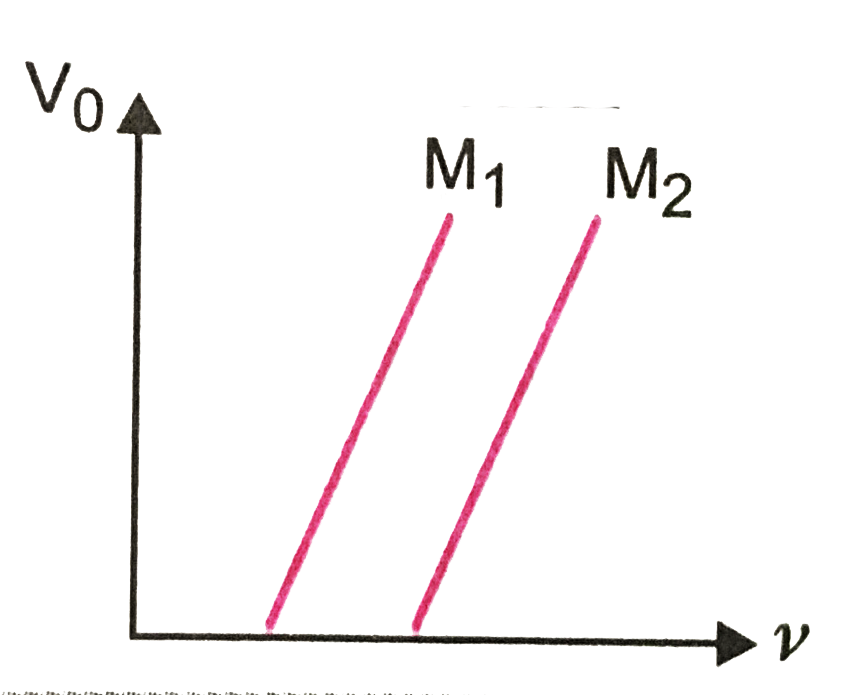
(i) why is the slope same for both lines?
(ii) For which material will the emitted electrons have greater kinetic energy for the incident radiations of the same frequency? Justify your answer.View SolutionQuestion 58
A lamp mainly emits light of wavelength λ. The lamp is rated at P watt and 8% of the energy is emitted as visible light.
(i) How many photons of light are emitted by the lamp per second?
(ii) How many photons are falling per second on a square whose length of each side is a, held perpendicular to the incident photons at a distance r from the lamp. View SolutionQuestion 61
X-ray fall on a photosenstive surface to cause photoelectric emission. Assuming that the work function of the surface can be neglected, find the relation between the de -Broglie wavelength (λ) of the electrons emitted to the energy (Ev) of the incident photons. Draw the nature of the graph for λ as a function of Ev.View SolutionQuestion 68
The graph of Fig. shows the variation of photoelectric current (I) versus applied voltage (V) for the two different photosensitive materials for two different intensities of the incident radiation. Identify the pairs of curves that correspond to different materials but same intensity of incident radiation.
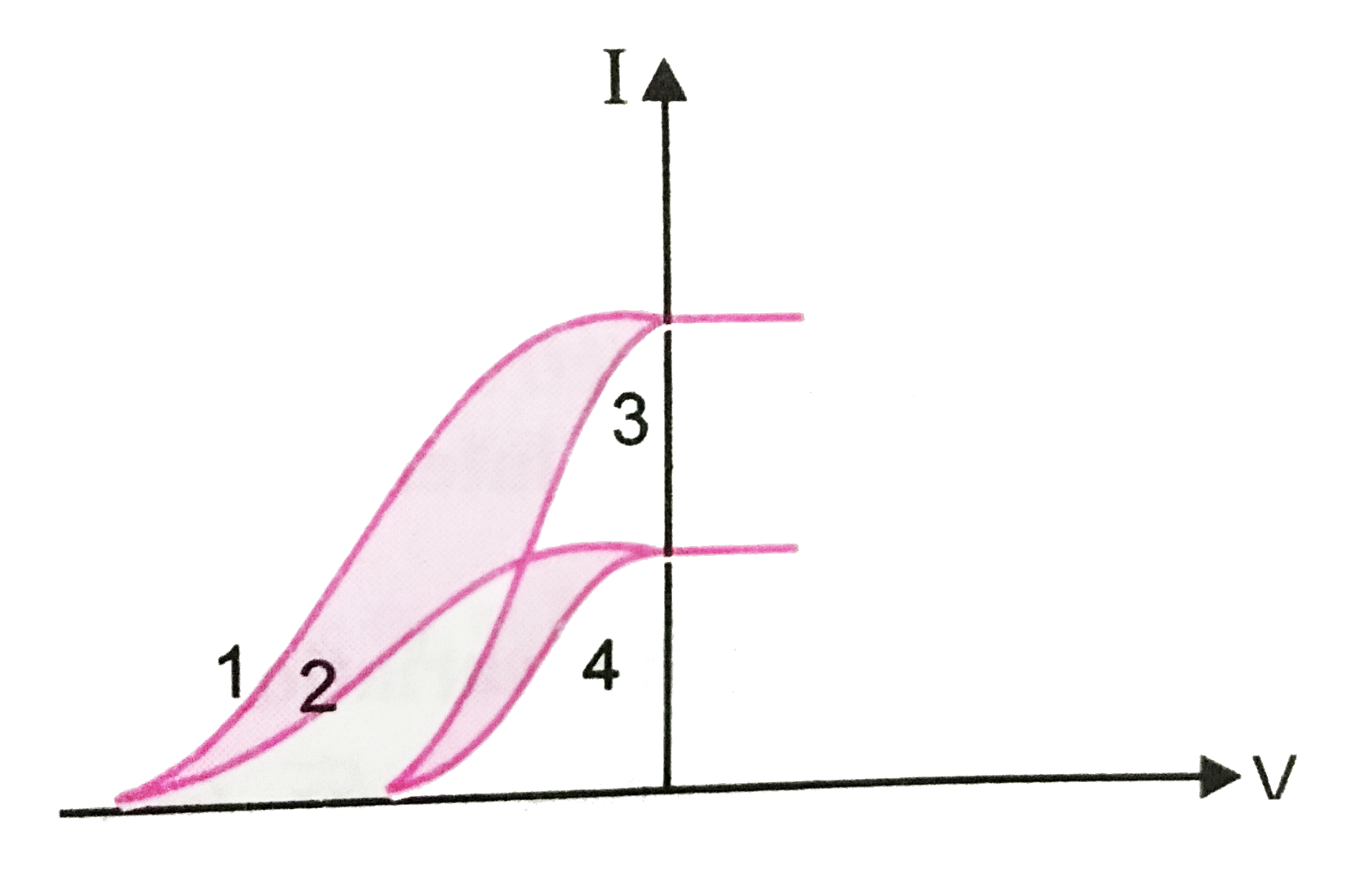 View Solution
View SolutionQuestion 72
The Fig shows a plot of three curves a, b, c showing the variation of photocurrent versis collector plate potential for the different intensities I1,I2andI3 having frequencies v1,v2andv3 respectively, incident on a photosensitive surface. Point out the two curves for which the incident radiation have same frequency but different intensities.
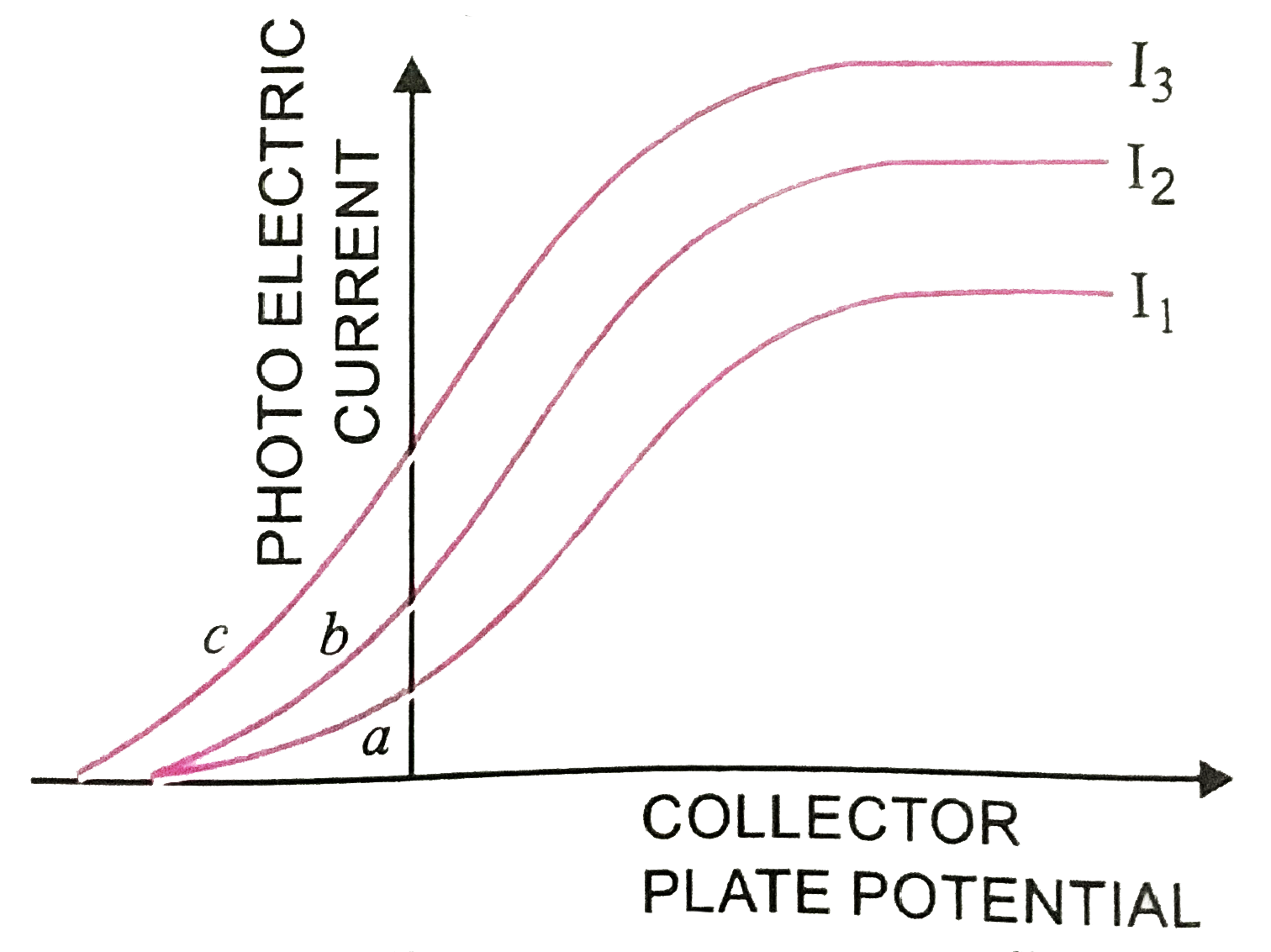 View Solution
View SolutionQuestion 129
Radiations of frequencies v2andv2 are made to fall in turn, on a photosenstive surface. The stopping potential required for stopping the most energetic photoelectrons in the two cases are V1andV2 respectively. Obtain a formula for determining the threshold freqeuncy in terms of these parameters.View SolutionQuestion 131
When a given photosenstive material is irradiated with light of frequency v, and maximum speed of the emitted photoelectrons equals vmax. The square of vmaxis observed to very with v, as per the graph shown in fig. Obtain expression for (i) Planck's constant and (ii) the work function of the given photosenstive material, in terms of the parameter l, n and the mass m of the electrons.
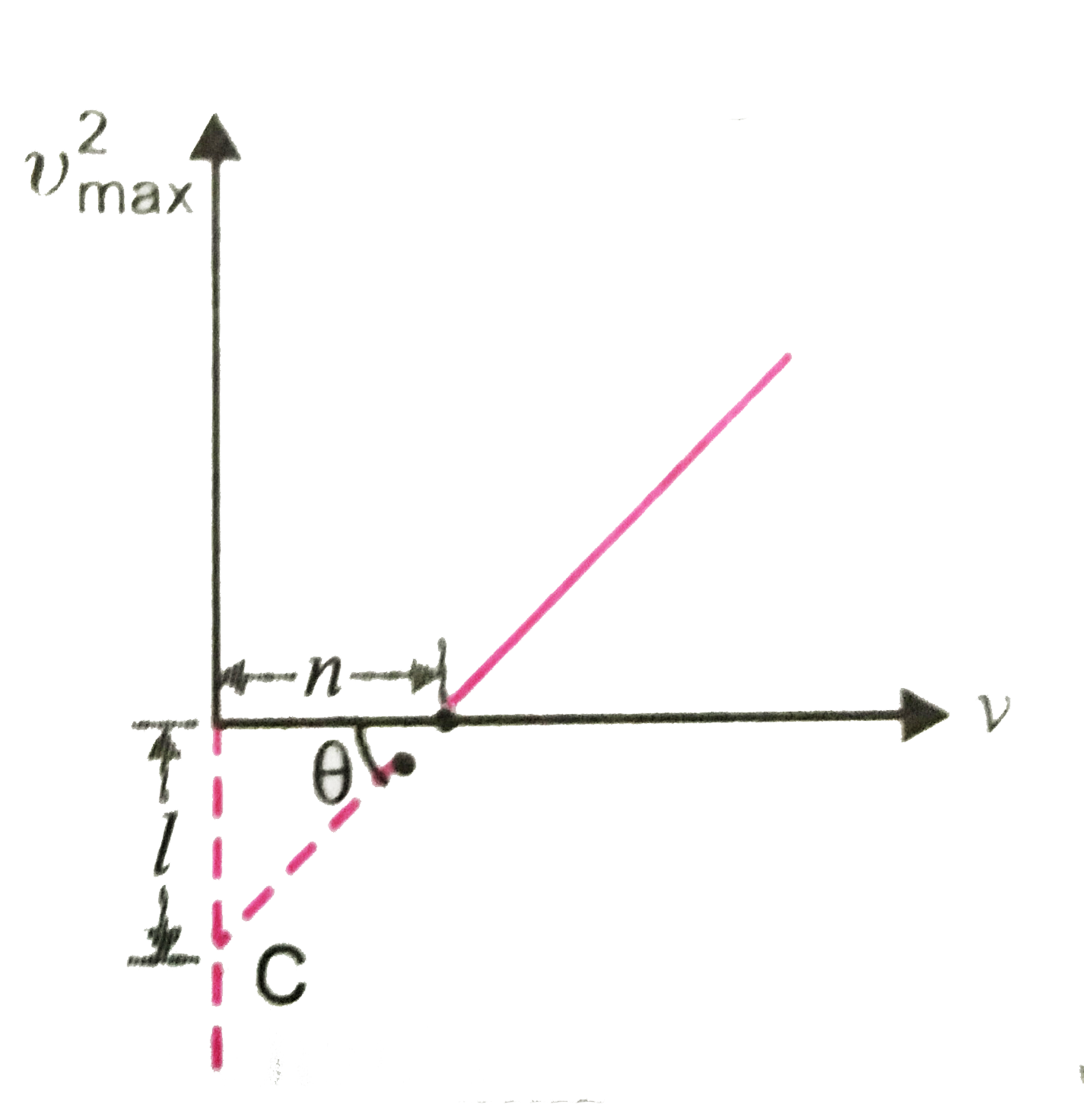 View Solution
View SolutionQuestion 137
State how in a photo-cell, the work function of the metal influence the kinetic energy of the emitted electrons.
(a) If the intensity of the incident radiation is doubled, what change occur in (i) the stopping potential and (ii) in photoelectric current?
(b) If the frequency of the incident radiation is doubled, what changes occur in the (i) stopping potential and (ii) photoelectric current.View SolutionQuestion 139
The threshold frequency of a metal is f0. When the light of frequency 2f0 is incident on the metal plate, the maximum velocity of electrons emitted is v1. When the frequency of the incident radiation is increased to 5f0, the maximum velocity of electrons emitted is v2. Find the ratio of v1andv2.View SolutionQuestion 143
In a photoelectric effect experiment, the graph between the stopping potential (V) and frequency (v) of the incident radiations on two different metal plates P and Q are shown in plates, P and Q has greater value of work function ? (ii) What does the slope of the lines depict?
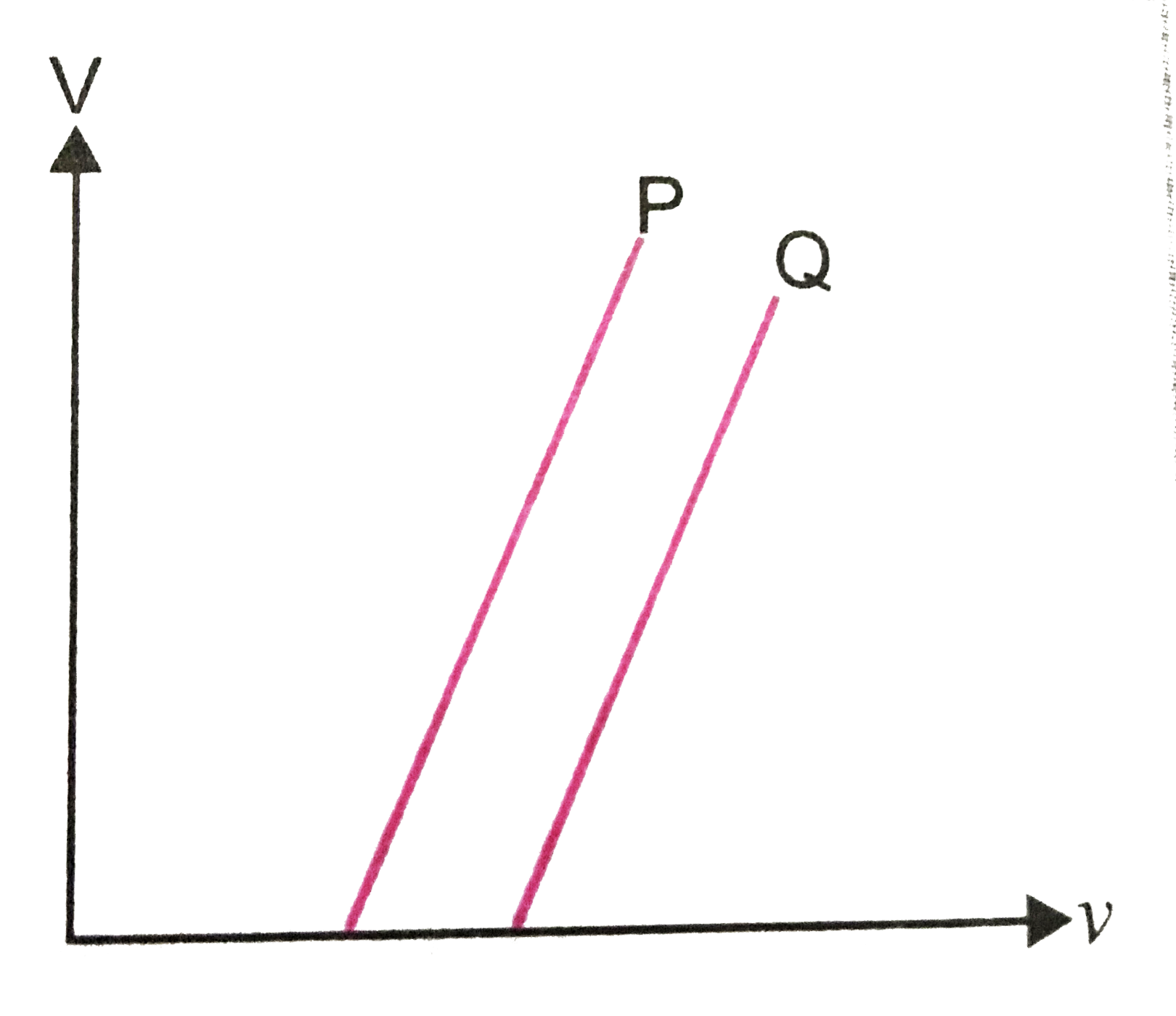 View Solution
View SolutionQuestion 164
Light of intensity I and frequency v is incident on a photosenstive surface and causes photoelectric emission. What will be the effect on anode current when (i) the intensity of light is gradually increased, (ii) the frequency of incident radiation is increased and (iii) the anode potential is increased? In each case, all other factors remains the same. Explain, giving justification in each case. View SolutionQuestion 170
Sketch a graph between frequency of incident radiations and stopping potential for a given photosenstive material. What information can be obtained from the value of the intercept on the potential axis? A source of light of frequency greater than the threshold frequency is placed at a distance of 1m from the cathode of a photocell. The stopping potential is found to be V. If the distance of the light source from the cathode is reduced, explain giving reasons, what change will you observe in the (i) photoelectric current (i) stopping potential?View SolutionQuestion 171
Sketch the graphs, showing the variation of stopping potential Vs with frequency v of the incident radiations for two photosensitive materials A and B having threshold frequencies v0>v'0 respectively.
(i) which of the two metals A or B has higher work function?
(ii) What information do you get from the slope of the graphs?
(iii) What does the value of the intercept of graph A on the potential axis represent? View SolutionQuestion 172
In a plot of photoelectric current versus anode potential, how does
(i) the saturation current vary with anode potential for incident radiations of different frequencies but same intensity?
(ii) the stopping potential vary for incident radiations of different intensities but the same frequency?
(iii) Photoelectric current vary of different intensities but same frequency of incident radiation? justify your answer is each case.View SolutionQuestion 173
(i) State two important features of Einstein's photoelectric equation.
(ii) Radiation of frequency 1015Hz is incident on two photosenstive surface P and Q. There is no photoemission from surface P. Photoemission occurs from Q but photoelectrons have zero kinetic energy. Explain these observation and find the value of work function for surface Q.View SolutionQuestion 174
Explain giving reasons for the following :
(a) Photoelectric current in a photocell increases with the increases in intensity of the incident radiation.
(b) The stopping potential (V0) varries linearly with the frequency (v) of the incident radiation for a given photosenstive surface with the stop remaining the same for different surfaces.
(c) Maximum kinetic energy of the photoelectrons is independent of the intensity of incident radiation. View SolutionQuestion 175
The following graph shows the variation of photoelectric current for a photosensitive metal .
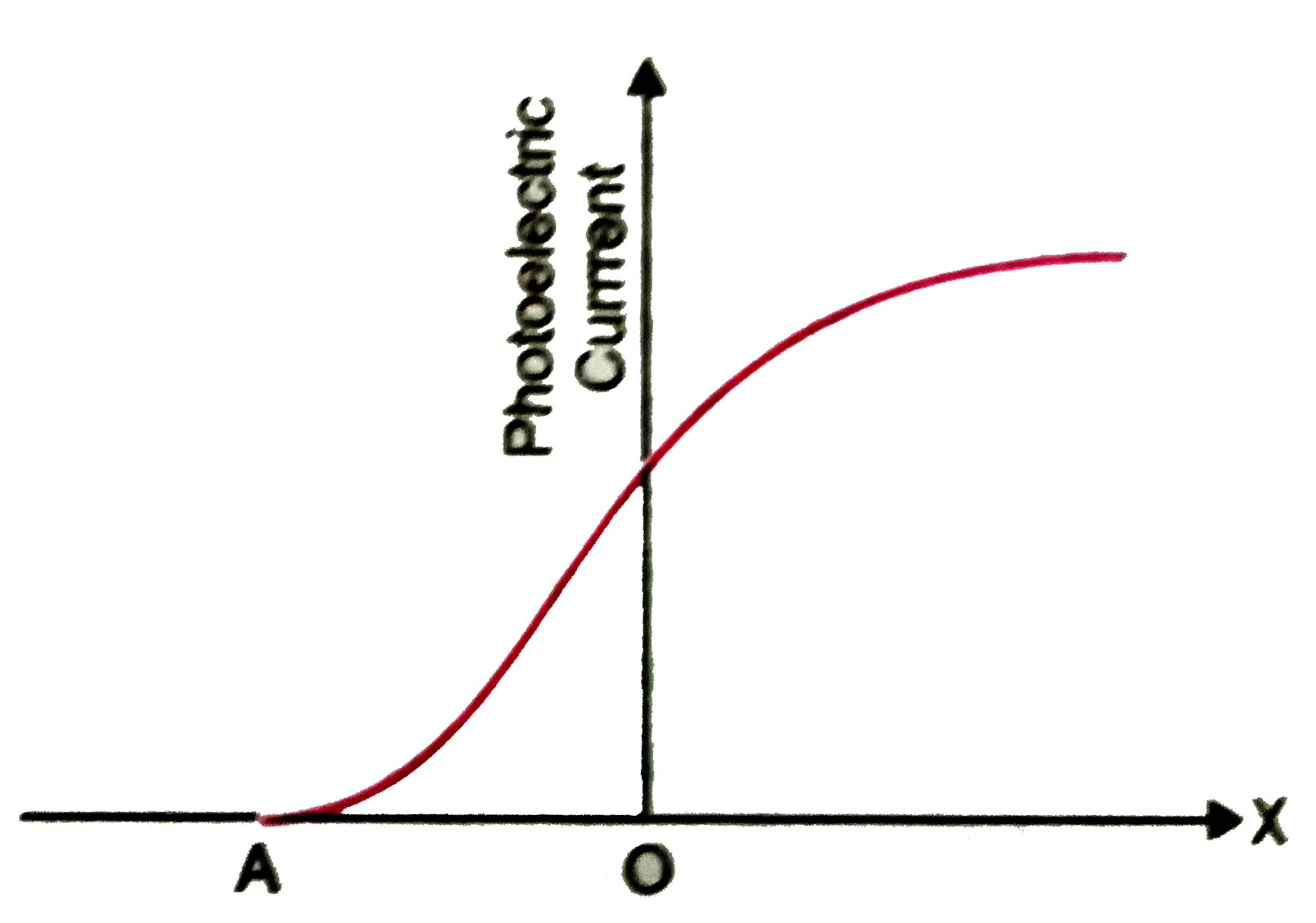
(a) Identify the variable X on the horizontal line.
(b) What does the point A on the horizontal axis represent?
(c) Draw this graph for three different values of frequencies of incident radiation v1,v2andv3(v1>v2>v3) for same intensity.
(d) Draw this graph for three different values of intensities of incident radiation I1,I2,I3(I1>I2>I3) having same frequency.View SolutionQuestion 180
What is photoelectric effect? Explain experimentally the variation of photoelectric current with (i) the intensity of the incident light (ii) the potential difference between the plates and (iii) the frequency of the incident light and hence state the laws of photoelectric emission.View SolutionQuestion 182
What is photoelectric effect? Give any two practical applications of this effect. Write Einstein's photoelectric equation and use it to explain (i) independence of maximum energy of the emitted photoelectrons from intensity of incident light (ii) existence of a threshold frequency of the emitted photoelectrons from intensity of incident light. View SolutionQuestion 184
Light of intensity 10−5Wm−2 falls on a sodium photocell of surface area 2cm2. Assuming that the top 5 layers of sodium absorb the incident energy, estimate the time required for photoelectric emission in the wave picture of radiation. The work function of the metal is givent to be about 2eV. What is the implication of your answer? effective atomic area =10−20m2.View SolutionQuestion 185
Estimate the following the following two numbers should be interesting. The first number will tell you why radio engieers do not need to worry much about a photons. The second number tells you why our eye can never "count photon" even in barely detectable light.
(i) The number of photons emitted per second by a MW transmitter of 10kW power emitting radiowaves of length 500m.
(ii) The number of photons entering the pupil of our eye per second corresponding to the minimum intensity of white light that we humans can precieve (~10−10Wm−2). Take the area of the pupil to be about 0.4cm2, and the average frequency of white light to be about 6×104Hz.(h=6.6×10−34J)View SolutionQuestion 186
In an experiment on photoelectric emission of γ-rays on platinum, the energy distribution of photoelectron exhibits peaks at a number of descrete energies : 270keV, 339keV and 354keV. The binding energy of K,L and M shell in platinum are known to be 77keV, 13keV and 3.5keV approx., what is the wavelength of γ-rays with which the data are consistent.View SolutionQuestion 187
An X-ray pulse of wavelength 4.9Å is sent through a section of Wilson cloud chamber containing a super saturated gas, and tracks of photoelectrons ejected from the gaseous atom are observed. Two groups of tracks of length 1.40cm and 2.02 cm are noted. If the range-energy relation for cloud chamber is given by R=αE, with α=1cm/keV, obtain the binding energies of two levels from which electrons are emitted. Given h=6.63×10−34Js,e=1.6×10−19C.View SolutionQuestion 188
When a surface is irradiated with light of wavelength 4950Å, a photocurrent appears which vanishes if a retarding potential appears which vanishes if a retarding potential greater than 1.2 volt is applied across the phototube. When a different source of light is used, it is found that the critical retarding potential is changed to 2.1 volt. Find the work function of the emitting surface and the wavelength of second source. If the photoelectrons (after emission from the surface) are subjected to a magnetic field of 10 tesla, what changes will be observed in the above two retarding potentials. Use h=6.6×10−34Js,e=1.6×10−19C.View SolutionQuestion 189
A beam of light has three wavelengths 4144Å, 4972Å and 6216Å with a total instensity of 3.6×10−3Wm−2 equally distributed amongst the three wavelengths. The beam falls normally on an area 1.0cm2 of a clean metallic surface of work function 2.3 eV. Assume that there is no loss of light by reflection and that each energetically capable photon ejects on electron. Calculate the number of photo electrons liberated in two seconds.View SolutionQuestion 190
A monochromatic light soure of frequency f illuminates a metallic surface and ejects photoelectrons. The photoelectrons having maximum energy are just able to ionize the hydrogen atoms in ground state. When the whole experiment is repeated with an incident radiation of frequency 56f, the photoelectrons so emitted are able to excite the hydrogen atom beam which then emits a radiation of wavelength 1215Å. (a) What is the frequency of radiation? (b) Find the work- function of the metal. View SolutionQuestion 191
A small plate of a metal (work function =1.7eV) is placed at a distance of 2m from a monochromatic light source of wavelength 4.8×10−7m and power 1.0watt. The light falls normally on the plate. Find the number of protons striking the metal plate per square metre per second. If a constant magnetic field of strength 10−4T is applied parallel to the metal surface, find the radius of the largest circular path followed by the emitted photoelectron. (use h=6.63×10−34Js , mass of electron=9.1×10−31kg, charge of electron=1.6×10−19CView SolutionQuestion 192
Light of wavelength 180 nm ejects photoelectrons from a plate of metal whose work - function is 2 eV. If a uniform magnetic field of 5×10−5 T be applied parallel to the plate, what would be the radius of the path followed by electrons ejected normally from the plate with maximum energy.View SolutionQuestion 193
A 40 W ultraviolet light source of wavelength 2480A. Illuminates a magnesium (mg) surface placed 2 m away. Determine the number of photons emitted from the surface per second and the number incident on unit area of Mg surface per second . The photoelectric work function for Mg is 3.68eV. Calculate the kinetic energy of the fastest electrons ejected from the surface. Determine the maximum wavelength for which the photoelectric effects can be observed with Mg surface.View SolutionQuestion 194
A cylindrical rod of some laser material 5×10−2m long and 10−2m in diameter contains 2×1025 ions per m3. If on excitation all the ions are in the upper energy level and de-excite simultaneously emitting photons in the same direction , calculate the maximum energy contained in a polse of radiation of wavlength 6.6×10−7m. If the pulse lasts for 10−7s, calculate the average power of the laser during the pulse.View SolutionQuestion 199
The work function of caesium is 2.14 eV. When light of frequency 6×1014Hz is incident on the metal surface, photoemission of electrons occurs. What is the (a) maximum kinetic energy of the emitted electrons. (b) stopping potential and (c) maximum speed of the emitted photoelectrons. given , h=6.63×10−34Js,1eV=1.6×10−19J,c=3×108m/s.View SolutionQuestion 201
Monochromatic light of wavelength 632.8nm is produced by a helium-neon laser. The power emitted is 9.42 mW. (a) Find the energy and momentum of each photon in the light beam. (b) How many photons per second, on the average, arrive at a target irradiated by this beam? (Assume the beam to have uniform cross-section which is less than the target area). (c) How fast does a hydrogen atom have to travel in order to have the same momentum as that of the photon. h=6.663×10−34Js,1a.m.u.=1.66×10−27kg.View SolutionQuestion 204
A 100W sodium lamp radiates energy uniformly in all directions. The lamp is located at the centre of a large sphere that absorbs all the sodium light which is incident on it. The wavelength of the sodium light is 589nm. (a) What is energy associated per photon with the sodium light? (b) At what rate are photons delivered to the sphere?View SolutionQuestion 208
Light of wavelength 488 nm is produced by an atom laser which is used in the photoelectric effect. When light from this spectral line is incident on the cathode, the stopping potential of photoelectrons is 0.38eV. Find the work function of the material from which the cathode is made. given , h=6.63×10−34Js,1eV=1.6×10−19J.View SolutionQuestion 214
A. For what kinetic energy of neutron will the associated de Broglie wavelength be 1.40×10−10m?
B. Also, find the de Broglie wavelength of a neutron, in thermal equilibrium with matter, having an average kinetic energy of (32) kT at 300K. Given the mass of neutron=1:66×10−27kg and k=1.38×10−23Jkg−1.View SolutionQuestion 216
What is the de-Broglie wavelength of nitrogen molecule in air at 300K ? Assume that the molecule is moving with the root mean square speed of molecules at this temperature. (Atomic mass of nitrogen =14.0076U) Plank's constant=6.63×10−34Js , Boltzmann constant =1.38×10−23JK−1View SolutionQuestion 217
(a) Estimate the speed with which electrons emitted from a heated cathode of an evacuated tube impinge on the anode maintained at a potential difference of 500 V with respect to the cathode. Ignore the small initial speeds of the electrons. The specific charge to of the electron, i.e., its e/m is given to 1.76×1011Ckg−1.
(b) Use the same formula you employ in (a) to obtain electron speed for an anode potential of 10 MV. Do you see what is wrong? In what way is the formula to be modified?View SolutionQuestion 218
(a) A monoenergetic electron beam with electron speed of 5.20×106ms−1 is subjected to a magnetic field of 1.30×10−4T, normal to the beam velocity. What is the radius of the circle traced by the beam, given e/m for electron equal 1.76×1011C.kg−1.
(b) Is the formula you employ in (a) valid for calculating radius of the path of 20 MeV electrons beam? If not, in what way is it modified!View SolutionQuestion 219
An electron gun with its anode at a potential of 100V fires out electrons in a spherical bulb containing hydrogen gas at low pressure (10−2nmofHg). A magnetic field of 2.83×10−4T curves the path of the electrons in a circular orbit of radius 12.0 cm. (The path can be viewed becuase the gas ions in the path focus the beam by attracting electrons and emitting light by electron capture, this method is known as 'fine beam tube' method). Determine e/m from the data.View SolutionQuestion 220
(a) An X-ray tube produces a continuous spectrum of radiation with its shorts wavelength end ate0.45Å. What is the maximum energy of the photon in the radiation? (b) From your answer to (a) , guess what order of accelerating voltage (for electrons) is required in such a tube?View SolutionQuestion 221
In an accelerator experiment on high energy collision of electrons with positrons, a certain events is interpted as annhilation of an electron-positron pair of total energy 10.2 BeV into two γ-rays of equal energy. What is the wavelength associated with each γ-rays? (1BeV=109eV)View SolutionQuestion 222
Estimate the following the following two numbers should be interesting. The first number will tell you why radio engineers do not need to worry much about a photons. The second number tells you why our eye can never "count photon" even in barely detectable light.
(i) The number of photons emitted per second by a MW transmitter of 10kW power emitting radiowaves of length 500m.
(ii) The number of photons entering the pupil of our eye per second corresponding to the minimum intensity of white light that we humans can perceive (~10−10Wm−2). Take the area of the pupil to be about 0.4cm2, and the average frequency of white light to be about 6×104Hz.(h=6.6×10−34J)View SolutionQuestion 223
Ultraviolet light of wavelength 2271Å from a 100W mercury souce irradiates a photocell made of molybdenum metal. If the stopping potential is 1.3V, estimate the work function of the metal. How would the photocell respond to a high intensity (~105Wm−2) red light of wave length 6328Å produced by a He-Ne laser?View SolutionQuestion 224
Monochromatic radiation of wave length 640.2 nm (1nm=10−9m) from a neon lamp irradiates a photosenstive material made of calcium or tungsten. The stopping voltage is measured to be 0.54V. The source is replaced by an iron source and its 427.2 nm line irradiates the same photocell. Predict the new stopping voltage.View SolutionQuestion 225
A mercury lamp is a convenient souce for studying frequency dependence of photoelectric emission, since it gives a number of spectral lines ranging from the UV to the end of the red vissible spectrum. In our experiment with rubidium photocell, the following lines from a mercury source were used: λ1=3650A∘,λ2=4047A∘,λ3=4358A∘,λ4=5461A∘,λ5=6907A∘ The stopping voltages, respectively were measured to be:
V01=1.28V,V02=0.95V,V03=0.74V,V04=0.16V,V05=0V.
(a) Determine the value of Planck's constant h.
(b) Estimate the threshold frequency and work function for the material.View SolutionQuestion 226
The work function for the following metals is given Na: 2.75 eV, K:2.30 eV , Mo: 4.17 eV , Ni: 515 eV.
Which of these metals will not give photoelectric emission for a radiation of wavelength 3300 A from a He−Cd laser placed 1m away from the photocell? What happens if the laser is brought nearer and placed 50 cm away?View SolutionQuestion 227
Light of intensity 10−5Wm−2 falls on a sodium photocell of surface area 2cm2. Assuming that the top 5 layers of sodium absorb the incident energy, estimate the time required for photoelectric emission in the wave picture of radiation. The work function of the metal is given to be about 2eV. What is the implication of your answer? effective atomic area =10−20m2.View SolutionQuestion 228
Crystal diffraction experiments can be performed using X-rays, or electrons accelerated through appropriate voltage. Which probe has greter energy? An X-ray photon or the electron? (For quantiative comparision, take the wavelength of the probe equal to 1Å, which is of the order of interatomic spacing in the lattice), me=9.11×10−31kg.View SolutionQuestion 229
(a) Obtain the de-Broglie wavelength of a neutron of kinetic energy 150 eV. As you have seen in previous problem 31, an electron beam of this energy is suitable for crystal differaction experiments. Would a neutron beam of the same energy be equally suitable? Explain. Given mn=1.675×10−27kg.
(b) Obtain the de-Broglie wavelength associated with thermal neutrons at room temperature (27∘C). Hence explain why a fast neutrons beam needs to be thermalised with the environment before it can be used for neutron differaction experiments.View SolutionQuestion 230
An electron microscope uses electrons accelerated by a voltage of 50kV. Determine the De Broglie wavelength associated with the electrons. If other factors ( such as numerical aperture, etc.) are taken to be roughly the same, how does the resolving power of an electron microscope compare with that of an optical microscope which uses yellow light?View SolutionQuestion 231
The wavelength of a probe is roughly a measure of the size of structure that it can probe in some detail. The quarks structure of photons and neutrons appears at the minute length -scale of 10−15m or less. This structure was first probed in early 1970's using high energy electron beam produced by a linear accelerator at Stanford's USA. Guess what might have been the order of energy of these electron beams (Rest mass energy of electron=0.511 eV).View SolutionQuestion 234
Answer the following questions:
(a) Quarks inside protons and neutrons are thought to carryfractional charges [(+2/3)e , (–1/3)e]. Why do they not show up in Millikan’s oil-drop experiment?
(b) What is so special about the combination e/m? Why do we not simply talk of e and m separately?
(c) Why should gases be insulators at ordinary pressures and start conducting at very low pressures?
(d) Every metal has a definite work function. Why do all photoelectrons not come out with the same energy if incident radiation is monochromatic? Why is there an energy distribution of photoelectrons?
(e) The energy and momentum of an electron are related to the frequency and wavelength of the associated matter wave by the relations:
E = h ν, p = λh
But while the value of λ is physically significant, the value of ν (and therefore, the value of the phase speed ν λ) has no physical significance. Why?View SolutionQuestion 236
(i) In the explanations of photoelectric effect, we assume one photon of frequency v collides with an electron and transfer its energy. This leads to the equation for the maximum energy Emax of the emitted electron as Emax=hv−ϕ0 Where ϕ0 is the work function of the metal. if an electron absorbs 2 photons (each of frequency v) what will be the maximum energy for the emitted electron?
(ii) Why is this fact (two photon absorption) not taken into consideration in our discussion of the stopping potential?View SolutionQuestion 246
Consider a thn target (10−2 m square, 10−3 m thinkness) of sodium, which produces a photocurrent of 100 μA when a light of intensity 100 W/m2(λ=660nm) falls on it. Find the probability that a photoenectron is produced when a photon strikes a sodium atom.
[Taken density of Na=0.97kg/m3]View SolutionQuestion 247
Consider an electron in front of metallic surface at a distance d (treated as an infinite plane surface). Assume the force of attraction by the plate is given as 14q24π∈0d2.
Calculate work in taking the charge to an infinite distance from the plate. Taking d=0.1nm, find the work done in electron volts. [Such a force law is not valid for d lt 0.1nm].View SolutionQuestion 248
A student performs an experiment on photoelectric effect, using two materials A and B. A plot of Vs⊤vs.ν is given in fig.
(i) Which material A or B has a higher work function?
(ii) Given the electric charge of an electron =1.6×10−19C, find the value of h obtained from the experiment for both A and B. Comment on whether it is consistant with Eistein's theory.
 View Solution
View SolutionQuestion 250
Consider a 20W bult emitting light of wavelength 5000Å and shinning on a metal surface kept at a distance 2m. Assume that the metal surface has work function of 2eV and that each atom on the metal surface can be treated as a circular disk of radius 1.5Å.
(i) Estimate no. of photons emitted by the bulb per second. [Assume no other losses] (ii) Will there be photoelectric emission? (iii) How much time would be required by the atomic disk to receive energy equal to work function (2eV)? (iv) How many photons would atomic disk receive within time duration calculated in (iii) above? (v) Can you explain how photoelectric effect was observed instantaneously? [Hing : Time calculated in part (iii) is from classical consideration and you may further take the target of surface area say 1cm2 and estimate what would happen?]View SolutionQuestion 252
A small metal plate of work function ϕ is kept at a distance r from a singly ionised, fixed ion. A monochromatic light beam is incident on the metal plate and photoelectrons are emitted. Find maximum wavelength of the light beam so that some of that electrons may go round the ion along a circle. View SolutionQuestion 259
Two metallic plates P (collector) and Q (emitter) are separated by a distance of 0.10 meter. These are connected through an ammeter without any cell. A magnetic field B exists parallel to the plates. Light of wavelength between 4000Åand6000Å fall on the plate whose work function is 2.39eV. Calculate the minimum value of B for which the current registered with ammeter is zero. Use, h=6.6×10−34Js,e=1.6×10−19CView SolutionQuestion 260
A 100W light bulb giving monochromatic light of wavelength 6000A∘ is placed at the centre of a spherical chamber of radius 0.20m. Assume that 50% of the energy supplied to the bulb is converted into light and that the surface of the chamber is perfectly absorbing. Find (i) the energy and momentum of each photon in the light beam.
(ii) How many photons per second, on the average arrive at the surface of spherical chamber, and
(iii) The pressure exerted by the light on the surface of the chamber. Given, h=6.6×10−34Js.View SolutionQuestion 262
Two neutral particles are kept 1m apart. Suppose by some machenism some charge is transferred from one particle to the other and the electric potential energy lost is completely converted into a photon. Calculate the longest and the next smaller wavelength of the photon possible. h=6.63×10−34Js.View SolutionQuestion 263
Light of wavelength 180 nm ejects photoelectrons from a plate of metal whose work - function is 2 eV. If a uniform magnetic field of 5×10−5 T be applied parallel to the plate, what would be the radius of the path followed by electrons ejected normally from the plate with maximum energy.View SolutionQuestion 265
Work function of a metal is the maximum amount of energy required by an electron, to just escape form the metal surface without any kinetic energy. The expression for work function of metal is ϕ0=hv0=hc/λ0, where h is Planck's constant, v0 is the threshold frequency, λ0 is the threshold wavelength and c is the velocity of light in vacuume. Read the above paragraph and answer the following questions:
(i) Why different metals have different work function?
(ii) What is the threshold wavelength of the incident radiation for a metal surface whose work function is 1.2eV.Givenh=6.63×10−34Js,1eV=1.6×10−19J.
(iii) What do you learn from this study?View SolutionQuestion 266
Radiation has dual nature, i.e., it possesess the properties of both, wave and particle. This prompted de-Broglie to prodict dual nature of moving material particles. Thus waves are associated with moving material particles which are called matter waves. The wavelength of matter waves is given by λ=hmv, where m is the mass, v is the speed of the particle and h is Planck's constant. Read the above paragraph and answer the following question:
(i) How was the wave nature of electron established?
(ii) What are the de-Broglie wavelength associated with a particle (i) at rest (ii) moving with infinite speed?
(iii) What are the basic values displayed by this study? View SolutionQuestion 267
According to Planck's quantum theory of light, every source of radiation emits photons (i.e., packets of energy ) which travel in all directions with the same speed (i.e., speed of light). Each photon is of energy E=hv=hc/λ, where h is Planck's constant, v is the frequency and λ is wavelength of radiation emitted. The photons emitted from different sources of radiation are different. Read the above passage and answer the following questions:
(i) on what factors does the number of photons emitted per second from a source of radiations depends?
(ii) Why are the high energy photons not vissible to eye?
(iii) Which basic values do you learn from this study? View SolutionQuestion 268
"Know your face beauty through complexion meter" was one of the stall on a science exhibition. A student interested to know his/her face beauty was made to stand on a platform and light from a lamp was made to fall on his/her face. The reading of complexion meter indicated the face beauty of the student which might be very fair, fair, semifair, semidark and dark, etc. Read abve passage and answer the following questions:
(i) What is the basic concept used in the working of complexion meter?
(ii) How is the face beauty recorded by face complexion meter?
(iii) What basic values do you learn from the above study? View SolutionQuestion 269
Photoelectric effect is a phenomenon of emission of electrons from the surfaces of a metal when the light of suitable frequency falls on it. If light of frequency v falls on a photosenstive surface of work function ϕ0, then the maximum kinetic energy of photoelectron emitted is given by Einstein's photoelectric equation.
(KE)max=12mv2max=hv−ϕ0
The value (KE)max will increases if the energy of the incident light (hv) increases of work function (ϕ0) is decreased. Read above passage and answer the following questions:
(i) Why can visible light not ejected photoelectrons from every surface?
(ii) Light of frequency 7.21×1014Hz is incident on a metal surface. Electrons with a maximum speed of 6.0×105ms−1 are ejected from the surface. What is the threshold frequency for photo emission of electrons? h=6.6×10−34Js,me=9.1×10−31kg.
(iii) What do you learn basically from the above study?View Solution


